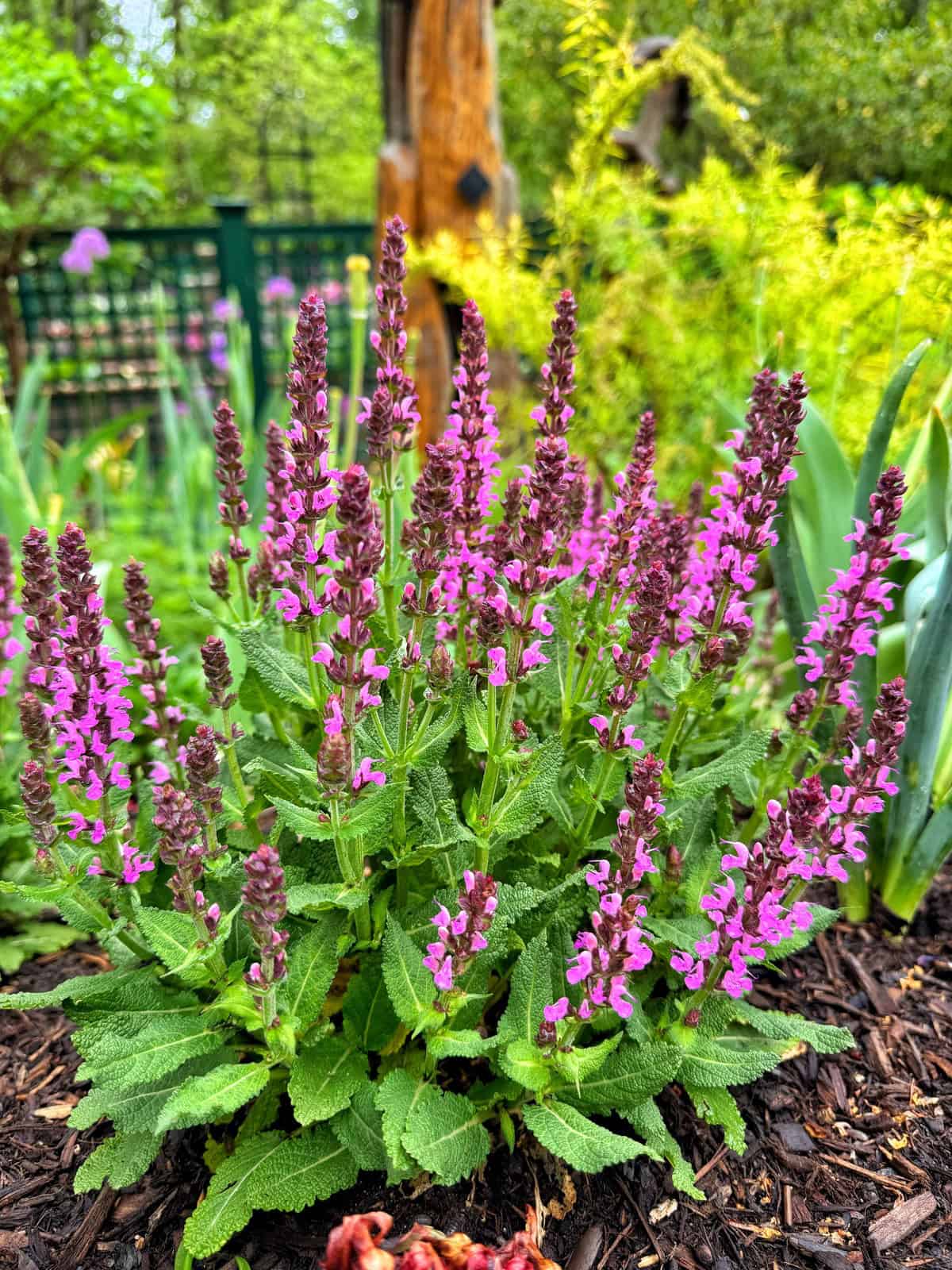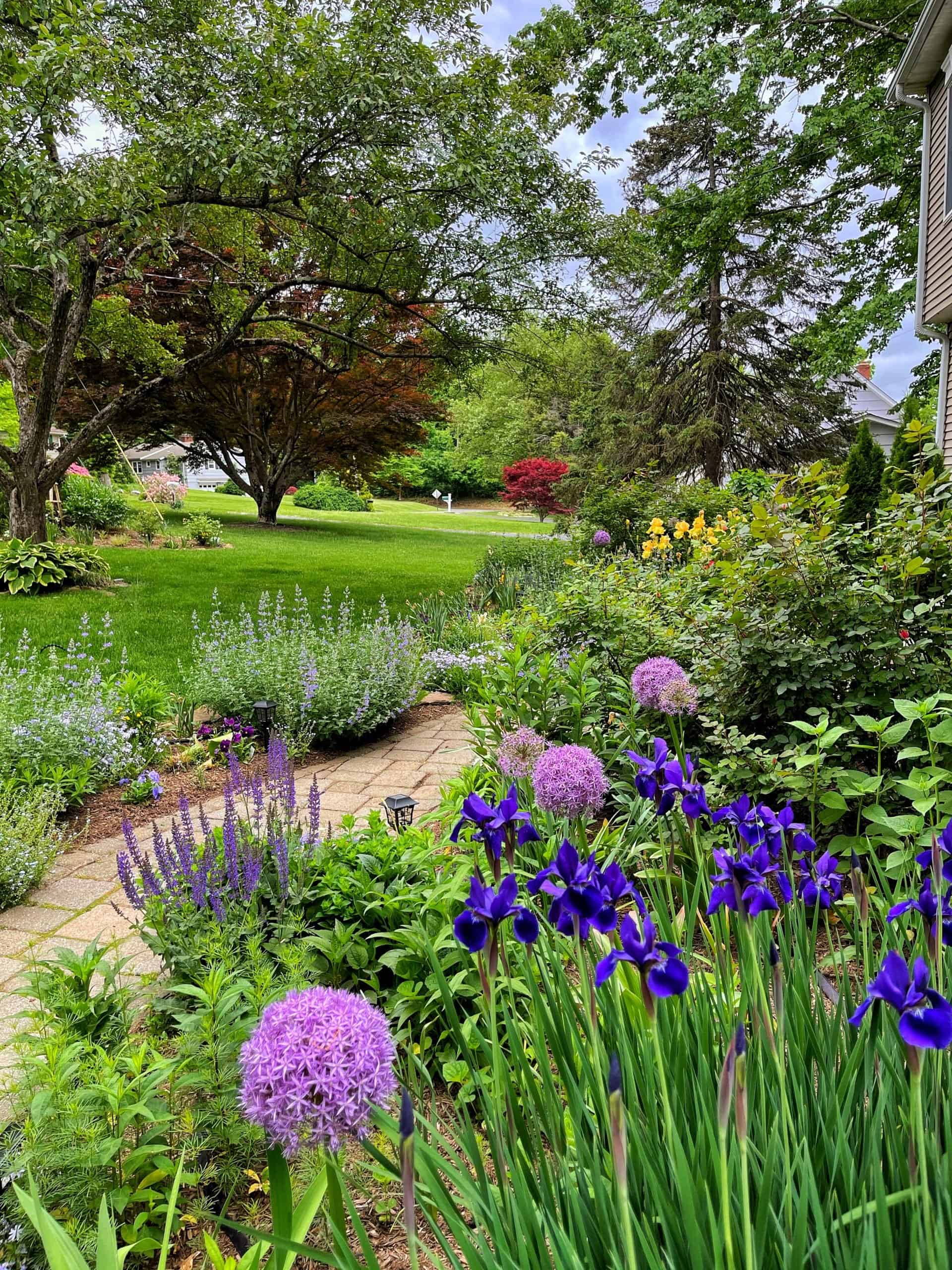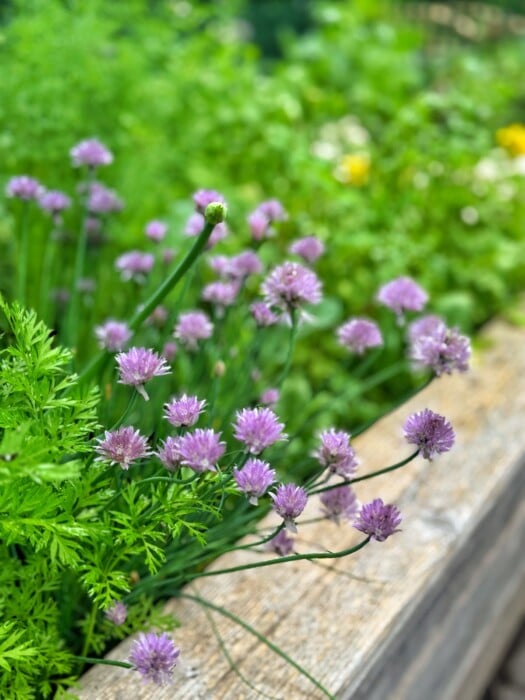Want a beautiful, low-maintenance cottage garden? Learn to grow the beautiful and versatile salvia plant with this simple guide!
Salvia, also known as sage, is a fantastic addition to any cottage garden. Prized for its vibrant and often long-lasting blooms, it brings a touch of informal elegance and attracts delightful pollinators like hummingbirds and butterflies. With a wide array of colors, sizes, and growth habits, there’s a salvia to suit every gardener’s taste and space. Best of all, these beauties are relatively low-maintenance, making them perfect for creating that relaxed and abundant cottage garden feel without excessive fuss.
(Posts on stacyling.com may contain affiliate links. Click HERE for full disclosure.)

About Salvia Plant
Salvia comes in a stunning array of colors, from deep purple and sky blue to fiery red and sunshine yellow. These vibrant blooms appear on tall spikes, adding texture and elegance to your flower beds, garden borders, or containers. As a medium-sized plant, they look beautiful when planted in groupings in the front or middle of the border.
And the best part? You can enjoy these gorgeous perennial plants from spring through summer. Butterfly and hummingbird lovers will also appreciate salvia, as its tubular flowers offer a sweet nectar reward for these pretty pollinators too.
- Genus: Salvia
- Common Name: Sage
- Plant Type: Perennial/Annual (This varies by species and climate)
- Hardiness Zone: Varies significantly by species (e.g., some are hardy in zones 4-8, while others are tender annuals). We’ll discuss specific zones for popular varieties later.
- Light: Full Sun (at least 6-8 hours of direct sunlight daily)
- Soil Requirements: Well-drained soil; tolerates a range of soil types but prefers moderately fertile soil.
- Height: Varies by species, ranging from 1 to 5 feet.
- Width: Varies by species, ranging from 1 to 4 feet.
- Flower Color: Diverse, including shades of blue, purple, red, pink, white, yellow, and bi-colors.
- Foliage Color: Typically green, but some varieties offer silver, gray-green, or variegated foliage.
- Bloom Time: Spring through fall, with deadheading often encouraging continuous flowering.

Why Choose Salvia Plant?
Unlike some high-maintenance flowers, salvia almost thrives on neglect. This makes it a perfect choice for busy gardeners who don’t have hours to spend tending to their flower beds. Salvia is also naturally drought-tolerant once established, so you won’t have to worry about constant watering during hot summer days. Plus, pollinators love it and deer tend to avoid browsing it too, thanks to its slightly fuzzy leaves and scented foliage.
Choosing the Right Salvia for Your Cottage Garden
The world of salvia is vast! To help you select the perfect additions to your cottage garden, let’s look at some popular and reliable choices:
- Salvia nemorosa (Woodland Sage): A cottage garden favorite, known for its spikes of violet-blue flowers. It’s generally hardy in USDA zones 3-8 and is quite easy to care for. Many cultivars exist, offering variations in height and flower color (including pink and white).
- Salvia guaranitica (‘Black and Blue’): If you want to attract hummingbirds, this is your salvia! Its striking cobalt blue flowers emerge from nearly black calyces. Typically grows in zones 7-10 and can reach 3-5 feet tall.
- Salvia x sylvestris (‘Blue Marvel’): A compact and sturdy hybrid that offers masses of true blue flowers. It’s hardy in zones 4-8 and is a great choice for smaller spaces or the front of borders.
- Salvia coccinea (Scarlet Sage): Though often grown as an annual, this salvia readily self-seeds in warmer climates. It offers vibrant flower spikes in shades of red, as well as pink and white cultivars.
- Salvia greggii (Autumn Sage or Texas Sage): Perfect for warmer climates (zones 7-10), this salvia blooms prolifically from spring through fall with little fuss. You’ll find varieties in a delightful array of colors, including red, pink, orange, purple, and white.
Consider your local climate (hardiness zone), the amount of space you have, and the colors you love when making your selections.

Planting Your Salvia Plant
Getting your salvia off to a good start is key to a season of beautiful blooms:
- When to Plant: For potted salvia plants, spring or fall are ideal planting times, allowing the roots to establish before extreme temperatures arrive. If starting from seed, sow indoors 6-8 weeks before your last expected frost.
- Where to Plant: Salvias thrive in a sunny location, requiring at least 6-8 hours of direct sunlight each day to flower their best.
- Soil: Well-drained soil is crucial for salvia. They don’t like to sit in soggy conditions. If your soil is heavy clay, amend it with compost or perlite to improve drainage.
- Spacing: Give your salvia plants adequate space to grow and for good air circulation, which helps prevent diseases. Space them about 24 to 36 inches apart, depending on the mature size of the variety.
How to Plant Salvia Flowers
- Dig a hole that is twice as wide as the root ball of your salvia plant and just as deep.
- Gently remove the plant from its container and loosen any circling roots.
- Place the plant in the center of the hole, ensuring the top of the root ball is slightly above the surrounding soil level.
- Fill the hole with the amended soil, gently firming it around the base of the plant.
- Water thoroughly after planting.
- Apply a layer of mulch around the base of the plant (keeping it away from the stem) to help conserve moisture and suppress weeds.

Caring for Your Salvia Plant
One of the joys of growing salvia is its relatively low-maintenance nature:
- Fertilizing: Salvias are not heavy feeders. A light application of a balanced, slow-release fertilizer in early spring is usually sufficient to support healthy growth and flowering. Avoid excessive fertilization, which can lead to leggy growth and fewer blooms. While some like fertilizing, I recommend focusing more on soil quality. Amend with lots of organic matter, compost, and leaf mold to help with drainage and fertility.
- Watering: Once established, most salvia varieties are quite drought-tolerant. However, they will appreciate occasional watering during dry spells, especially during their first growing season. Avoid overwatering, as this can lead to root rot.
- Pruning: Deadheading, or removing spent flower spikes, is essential to encourage continuous blooming throughout the season. Simply snip off the faded flower stalks below the spent blooms to get a second set of flowers. For perennial salvias, you can cut back the foliage close to the ground after it has been damaged by a hard freeze in the fall.
- Potential Issues: Generally, salvias are relatively pest and disease-free. However, keep an eye out for common garden pests like leafhoppers and aphids. Powdery mildew can sometimes occur, especially in humid conditions with poor air circulation. Providing adequate spacing can help prevent this.
To learn more about deadheading salvia plant, read this post that I wrote.

Growing Salvia in Pots
Salvia also grows well in containers, making it a versatile option for balconies, patios, and small gardens. For plants to return each year, select varieties that are at least two zones hardier than your local climate.
Dividing Salvia
If you want to increase your stock and maintain plant health, the most common method of propagation is division.
Here’s how to do it:
- In the spring or early fall, dig up the entire plant, including its root ball.
- Gently separate the clumps of the plant by pulling them apart, using a knife or spade shovel if needed.
- Replant the divided clumps in well-draining soil at the same depth as the original plant.
- Water the divisions thoroughly and keep them well-watered until they establish new roots.
I’ve been doing this for many many years in my gardens with salvia plant. It divides easily and does well after replanting. While you can technically divide salvias anytime during the growing season, I recommend doing it in early spring when the plant breaks ground or in fall as it starts to go dormant. It will be easier for you to establish them at this time as opposed to trying to do it during the summer heat.

Growing Salvia in Your Low-Maintenance Cottage Garden
Salvia’s natural, somewhat informal growth habit and vibrant flower spikes make it a perfect fit for the relaxed charm of a cottage garden. Here are some ways to incorporate it:
- Borders: Plant drifts of salvia along borders to create sweeps of color.
- Mass Plantings: For a dramatic effect and to attract a multitude of pollinators, consider mass plantings of a single salvia variety or a mix of complementary colors.
- Containers: Many smaller salvia varieties thrive in containers, adding vertical interest and pops of color to patios and decks.
- Companion Planting: Pair salvia with other classic cottage garden flowers for a harmonious and long-blooming display.
Companion Plants for Salvia
Since I’ve been growing salvias for almost my entire gardening life, I enjoy it with certain types of cottage garden flowers. Here are some of my favorites to grow with salvia plants.
- Rudbeckia
- Nepeta
- Coneflowers
- Coreopsis
- Sedum Autumn Joy
- Roses
- Bearded Iris
- Peonies
- Lavender
- Myostotis
- Monarda
- Lupines
- Petunias
- Gomphrena
- Pansies
- Euphorbia

Additional Tips for Salvia Plant Success
- Deer and Rabbit Resistance: Many salvia varieties are known for being deer and rabbit-resistant, making them a great choice if these garden visitors are a concern in your area.
- Propagation: You can easily propagate salvia through seeds, stem cuttings, or by division (for some perennial types).
- Observe and Learn: Pay attention to your specific salvia varieties and your local growing conditions. Adjust your care routine as needed to ensure they thrive.
With their beauty, resilience, and ability to attract beneficial wildlife, salvia plants are a wonderful addition to any low-maintenance cottage garden. Choose your favorites, give them a sunny spot and well-drained soil, and enjoy the colorful show!

Favorite Salvia Plant Varieties
Here are a few popular salvia varieties that I’ve grown to consider for your garden:
- May Night Salvia: This variety features deep indigo-blue blooms on tall spikes.
- Azure Snow: This variety boasts pretty blue flowers with touches of white on the petals.
- Big Red Salvia: As the name suggests, this salvia boasts fiery red flowers that attract hummingbirds.
- Pink Profusion: Enjoy these flowers on repeat throughout the summer with serious rebloom! Dark pink flowers are produced on darker pink calyxes on a perfectly rounded, dense and beautiful habit.
In my gardens, I gravitate to May Night and Pink Profusion. I love that hue and it performs well here in my zone 6b garden. I’ve been growing it since I started working with perennials and love the texture it adds to my cottage gardens.

More About Growing Salvia Plant in Your Cottage Garden
With their dazzling array of colors, long blooming season, and minimal care requirements, salvia plants are truly a gem for any garden, especially a low-maintenance cottage garden. For over 25 years, I’ve had the pleasure of growing several different salvia varieties right here in my own Zone 6b garden New Jersey. From the vibrant blues of Salvia nemorosa to the hummingbird-attracting Salvia guaranitica, these plants have consistently proven to be super easy to grow and incredibly low maintenance.
If you’re looking to learn how to grow a flower garden and want a rewarding and effortless experience, I recommend adding salvia to your plant list. Their beauty will enhance your outdoor space, attract beneficial pollinators, and leave you with more time to simply enjoy the charm of your cottage garden. Give salvia a try – you won’t be disappointed!
For more information on salvia varieties and care, check out this article from the Univerisity of Minnesota Cooperative extension.
Have you ever grown salvia before? If so, what are your favorite varieties? Let’s chat more in the comments below.
To drill down on more beginner gardening techniques and tips, please read these posts:
- Flower Gardening 101
- Growing a Cut Flower Garden for Beginners
- Container Garden Ideas for Beginners
- How to Start a Vegetable Garden
- Herb Gardening for Beginners
Thank you so much for following along.
Enjoy a beautiful day! xo


Looking for More Cottage Garden Ideas?
If you love cottage style gardening, here are some posts that will get you on your way.
- Cottage Gardening Mistakes You Don’t Want to Make and How to Fix Them
- The Best Cottage Garden Plants
- 5 Quick Ways to Grow a Cottage Garden
- Low-Maintenance Cottage Garden Ideas
- Perennials vs Annuals
- How My Cottage Garden Grew
- The Complete Guide to Roses Care
- The Basics of Hydrangea Care
- The Secret to Growing Foxgloves
- Purple Coneflower Care
- How to Grow Black-Eyed Susan
- The Secret to Growing an Everblooming Cottage Garden






